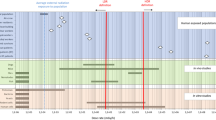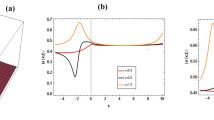Abstract
A model describing the key processes in Escherichia coli bacterial cells during base excision repair is developed. The mechanism is modeled of damaged base elimination involving formamidopyrimidine DNA glycosylase (the Fpg protein), which possesses several types of activities. The modeling of the transitions between DNA states is based on a stochastic approach to the chemical reaction description.
Similar content being viewed by others
References
T. Lindahl, “New Class of Enzymes Acting on Damaged DNA,” Nature 259, 64–66 (1976).
B. A. Sokhansanj et al., “A Quantitative Model of Human DNA Base Excision Repair. I. Mechanistic Insights,” Nucleic Acids Res. 30, 1817–1825 (2002).
D. T. Gillespie, “Exact Stochastic Simulation of Coupled Chemical Reactions,” J. Phys. Chem. 81, 2340–2361 (1977).
B. N. Ames and L. S. Gold, “Endogenous Mutagens and the Causes of Aging and Cancer,” Mutat. Res. 250, 3–16 (1991).
K. C. Cheng et al., “8-Hydroxyguanine, an Abundant Form of Oxidative DNA Damage, Causes G → T and A → C Substitutions,” J. Biol. Chem. 267, 166–172 (1992).
M. Moriya and A. P. Grollman, “Mutations in the mutY Gene of Escherichia coli Enhance the Frequency of Targeted G:C → T:A Transversions Induced by a Single 8-Oxoguanine Residue in Single-Stranded DNA,” Mol. Gen. Genet. 239, 72–76 (1993).
B. Epe, “DNA Damage Profiles Induced by Oxidizing Agents,” Rev. Physiol. Biochem. Pharmacol. 127, 223–249 (1995).
M. Dizdaroglu, J. Laval, and S. Boiteux, “Substrate Specificity of the Escherichia coli Endonuclease III Excision of Thymine- and Cytosine-Derived Lesions in DNA Produced by Radiation-Generated Free Radicals,” Biochemistry 32, 12105–12111 (1993).
A. F. Fuciarelli et al., “Yields of Radiation-Induced Base Products in DNA Effects of DNA Conformation and Gassing Conditions,” Intern. J. Rad. Biol. 58, 397–415 (1990).
J. Cadet et al., “Oxidative Damage to DNA: Formation, Measurement and Biochemical Features,” Mutat. Res. 531, 5–23 (2003).
O. S. Fedorova et al., “Stopped-flow Kinetic Studies of the Interaction between Escherichia coli Fpg Protein and DNA Substrates,” Biochemistry 41, 1520–1528 (2002).
J. Laval et al., “Antimutagenic Role of Base-Excision Repair Enzymes upon Free Radical-Induced DNA Damage,” Mutat. Res. 402, 93–102 (1998).
T. R. O’Connor and J. Laval, “Physical Association of the 2,6-Diamino-4-Hydroxy-5N-Formamidopyrimidine-DNA Glycosylase of Escherichia coli and an Activity Nicking DNA at Apurinic/Apyrimidinic Sites,” Proc. Nat. Acad. Sci. USA 86, 5222–5226 (1989).
V. Bailly et al., “Mechanism of DNA Strand Nicking at Apurinic/Apyrimidinic Sites by Escherichia coli [formamidopyrimidine] DNA Glycosylase,” Biochem. J. 262, 581–589 (1989).
R. J. Graves et al., “Excision of 5′-Terminal Deoxyribose Phosphate from Damaged DNA is Catalyzed by the Fpg Protein of Escherichia coli, J. Biol. Chem. 267, 14429–14435 (1992).
N. Krishnamurthy et al., “Efficient Removal of Formamidopyrimidines by 8-Oxoguanine Glycosylases,” Biochemistry 47, 1043–1050 (2008).
B. Castaing et al., “Cleavage and Binding of a DNA Fragment Containing a Single 8-Oxoguanine by Wild Type and Mutant FPG Proteins,” Nucleic Acids Res. 21, 2899–2905 (1993).
N. Gillard et al., “Radiation Affects Binding of Fpg Repair Protein to an Abasic Site Containing DNA,” Rad. Res. 162, 566–571 (2004).
R. L. P. Adams, J. T. Knowler, and D. P. Leader, The Biochemistry of the Nucleic Acids (Chapman and Hall, New York, 1992).
A. Kornberg and T. A. Baker, DNA Replication, 2nd ed. (Freeman, New York, 1992).
A. Chang et al., “BRENDA, AMENDA and FRENDA the Enzyme Information System: New Content and Tools in 2009,” Nucleic Acids Res. 37, D588–D592 (2009).
Author information
Authors and Affiliations
Additional information
Original Russian Text © O.V. Belov, 2011, published in Pis’ma v Zhurnal Fizika Elementarnykh Chastits i Atomnogo Yadra, 2011, No. 2(165), pp. 241–251.
The article was translated by the authors.
Rights and permissions
About this article
Cite this article
Belov, O.V. Modeling base excision repair in Escherichia coli bacterial cells. Phys. Part. Nuclei Lett. 8, 141–148 (2011). https://doi.org/10.1134/S1547477111020038
Published:
Issue Date:
DOI: https://doi.org/10.1134/S1547477111020038




